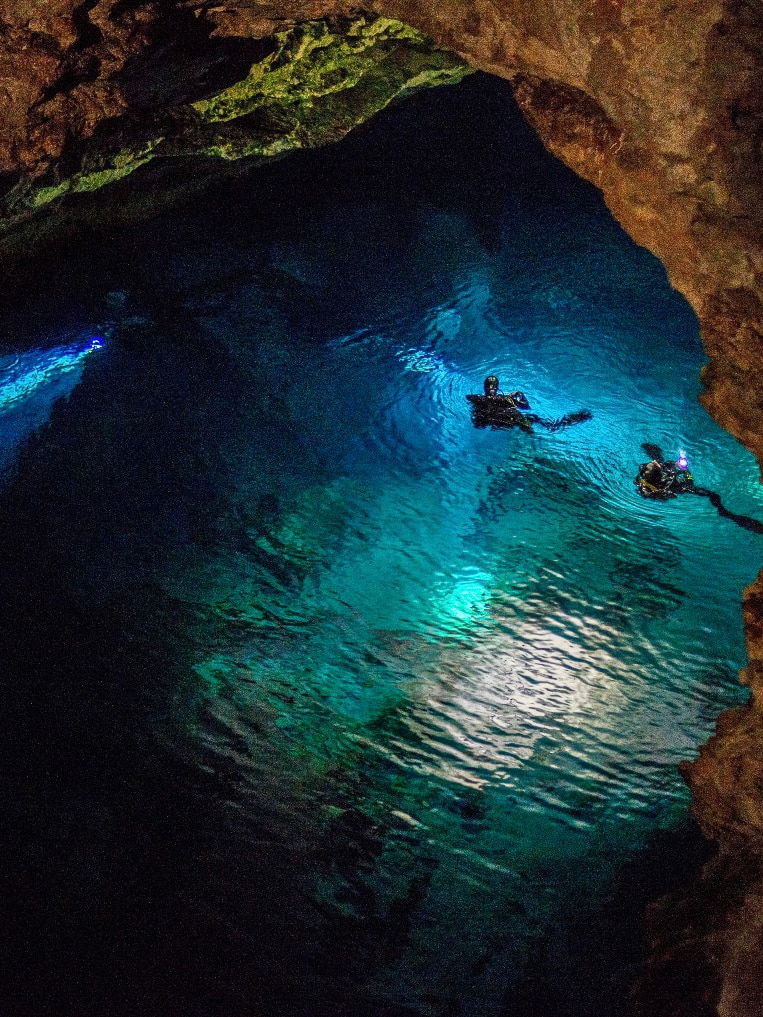Since he was a teenager, the sinkhole on fourth-generation farmer Graham Kilsby’s property has been his playground.
“I still joke … when we were 12 and above, Mum probably didn’t know quite where we were, but we were here exploring and climbing into the sinkhole, when we could,” he said.
About a decade ago, Mr Kilsby opened up his childhood playground, south of Mount Gambier on South Australia’s Limestone Coast, as a tourist attraction, bringing in visitors from interstate and overseas.
“We are the capital of sinkholes,” Mr Kilsby said.
“That’s due to our limestone and the volcanic activity thousands of years ago.
“The uniqueness of the sinkholes is one way that you can get people through the door, and then show them the rest of what’s available here.”
He said the region also offered wineries, the Glenelg River and good seafood, including crayfish.
“We have so much in this region. The opportunities are really endless,” Mr Kilsby said.
Growing attractions
At first, Mr Kilsby’s decision to turn the sinkhole into a tourism business was just a way to cover insurance.
“The cave divers were the only people that access the site, [and] what I got financially from the cave divers was very little,” he said.
“So that’s where I thought, ‘Well, what am I going to do? Shall I close the gate and close Kilsby Sinkhole, or is it something that I could grow and generate more income so that I could pay my insurance and still have it open to the general public?’
“So that’s when I decided to open it to open-water diving, which is insured and safe, which we did and then it evolved from there into freediving and snorkelling tours as well.”
As word spread about the sinkhole, Mr Kilsby said interest slowly grew to the point where tours were fully booked over long weekends and school holidays.
He has also added a gin distillery and accommodation at the site.
“We’re getting people from all around Australia coming to Mount Gambier, but we’re also getting that international market as well,” Mr Kilsby said.
Earlier this year, families on a trip from interstate landed four helicopters at Mr Kilsby’s property for a snorkelling tour.
“They were coming into Mount Gambier … and with a little bit of Googling, Kilsby Sinkhole came up,” he said.
“They thought it looked like a lovely experience and that’s how that came about.
“That was really cool.”
Unique geology
Mr Kilsby says his sinkhole is one of nearly 20 diveable sites in the region.
They also include Hell’s Hole, Tank Cave near Tantanoola, and the Little Blue Lake, which is also open for swimmers.
Cave Divers Association of Australia national director Grant Pearce said the Limestone Coast was unique due to its large number of easily accessible diving sites.
“Mount Gambier tends to [have] the ease of accessibility for cave divers to come to the region to practise their skills after they’ve done their training, and put all of that to the test,” he said.
“Once we’ve got our training levels and the approval from landholders, it’s quite easy for us to jump into the holes that we’re allowed to dive in — relative to our training — to go for a dive.
“The conditions are very good in the sense that visibility is perfectly clear.
“The walls of the caves are pure white limestone.”
While divers and dry cavers have been exploring underground on the Limestone Coast for decades, Mr Pearce said it was still “quite the adventure”.
“Cave diving these days represents the opportunities for folks to explore around where most people that don’t like it don’t get to visit,” he said.
“It’s still got that sense of adventure and we’re finding things all the time.”
Regional drawcards
Mr Kilsby said as the Limestone Coast’s sinkholes become better known, they could be used to attract people to experience the region’s other offerings.
“I think that there are so many more things we can do in the region to increase that visitor experience,” he said.
“A lot of people just want to know where they are.
“When people come here for our sinkholes and our caves, the benefits and the flow-on of those people coming to this region is incredible.
“People are really interested, and want to know more about them, so I think that we could even supply more information to these people that are really looking for that wonderful experience of visiting what we have.”
Mr Pearce said there was an opportunity for “South Australia to put Mount Gambier more on visitors’ lists for overseas visitors” by focusing on its caves and sinkholes.
“There’s not just cave diving, there’s also dry caving … where visitors can descend down steps into the sinkhole and have a look underground in a well lit environment and experience some of what we would see during a cave dive,” he said.
“Even domestically, across Australia there’s the opportunity for South Australia to really promote the uniqueness of the limestone landscape.”
Get our local newsletter, delivered free each Friday




